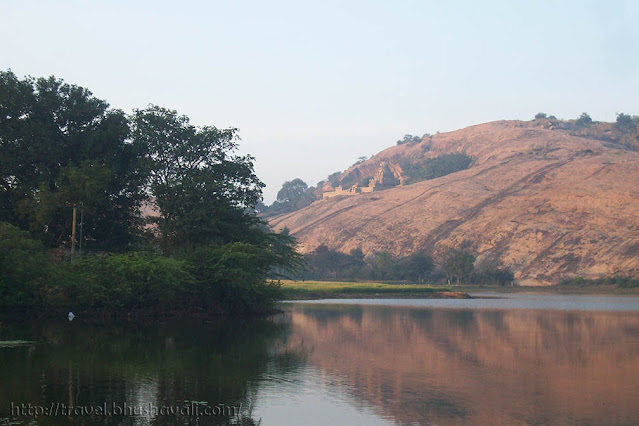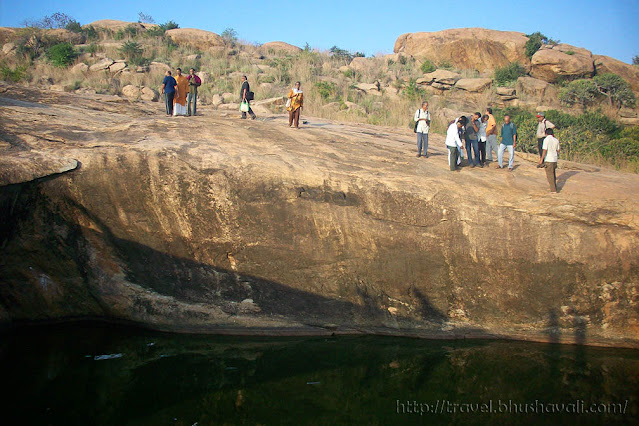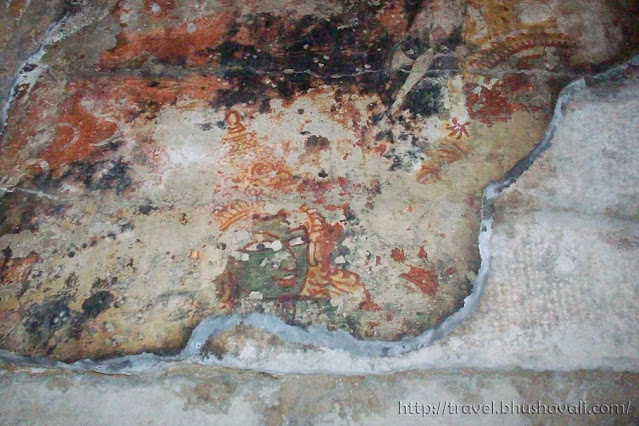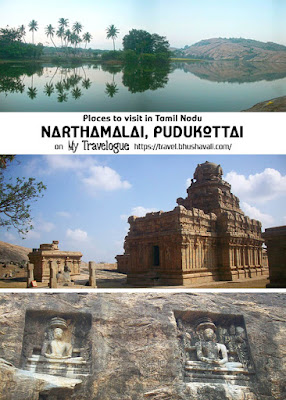HISTORY OF NARTTAMALAI / NARTHAMALAI
Narttamalai has had several names before it got its present name. It was called Malai Kadambur, later on, Telungu Kulakaala Puram, then Kulothunga Cholapuram, then on Nagarathar Malai and finally Narttamalai. More about who ruled this region coming up below... Read on...
MELAMALAI & ANIMADHA LAKE
Our first spot in Narttamalai was Melamalai where Vijayalaya Choleeswaram is located. This one is a temple located atop a small rocky hillock. Before going there, here's what we saw at the base of the hillock. Amazing isn't it? It was indeed a paradise!!! Early in the morning, before the sun rose, at 6 o'clock - absolutely heavenly!!!
This enormous water body is called Animadha Eri. This was excavated during the 7th - 8th C. The inscription about Animadha Eri says that Mallan Vidumban Muttraraiyan who was also called Thennalan Thamizhakaraiyan, excavated this lake for a carpenter named Cholaa Naraiyan. During this era, this region was under the Pallava empire but under the administration of Mutharaiyar-s.
From this point, the view of Vijayalaya Choleeswaram was just way too amazing. I was speechless! This is why we reached there at 6 am, to see the sun rays fall on Vijayalaya Choleeswaram, from this vantage point. Then we started climbing the rocky terrain.
NARTHAMALAI TOURIST PLACES
What we see here from atop the hill is one of the largest Tropical Dry Evergreen Forests! And from here is the perfect view of 5 other hills - Alurutti Malai, Kottai Malai, Kadambar Malai, Uvachan Malai, Man Malai.
JURAHARESWARAR TEMPLE, NARTHAMALAI
NARTHAMALAI CAVE TEMPLE
One more important thing to be noted before reached the temple is yet another temple, but easy to miss. Find the temple in the last pic above........ Found??? I'll wait. Take your time... Not yet. Ok. See that waterbody? That's the temple. Well... I mean, the temple is inside that waterbody - the Narthamalai Sivan Kovil. Its an eternal spring and beneath it, at 30 ft depth is a cave temple. This spring is called Talai-Aruvi-Singam Sunai. And in the temple is a single shrine of Jvara-Hareshwara. There was an inscription beside it too.
DROSERA SPATULATA INSECT-EATING PLANT
This region has its own set of natural wonders too! Prof.Swaminathan was sure of finding insect-eating carnivorous plants here and just around Thalai Aruvi Singam sunai, after a bit of searching, we did finally find Drosera Spatulata - Spoon Leaved Sundew!
VIJAYALAYA CHOLEESWARAM
NARTHAMALAI VIJAYALAYA CHOLEESWARAM TEMPLE HISTORY
Vijayalaya Choleeswaram was built by Ilango Adi Arayan aka Semboodhi. When was it built is a bit of confusion between mid 8th C and late 9th C. Later it was majorly renovated during the time of Mallan Vidhuman after it suffered damages. As mentioned above, when the Animadha Eri was excavated and till mid 9th C, the region was under the Pallavas. After that, Vijalaya Chola took over this region, defeating the Mutharayar-s. The temple got its current name after he took over in 13th C CE.
NARTHAMALAI VIJAYALAYA CHOLISWARA TEMPLE ARCHITECTURE & FRESCOES
Vijayalaya Choleeswaram is one of the most important temples of South India; one of the most important temples to study temple architecture. It is a west-facing the temple. Inside the sanctum sanctorum is a Shiva Lingam. Narthamalai Temple architecture is unique. Earlier it must have been a square Aavudaiyar (base of the lingam) in a Circular Sanctum Sanctorum. But now the Avudaiyar is circular and around the circular wall is another square wall! Renovation coupled with innovation! There is a tiny, narrow passage between the 2 walls.
In the Ardha Mandapam were some paintings, most probably of Nayak Period (17th C CE), but mostly gone! Have a look at the Narthamalai temple images above. On either side of the main shrines are the Dwarapala (Door Keepers), with fabulous outfit & ornaments. A bejewelled sacred thread with bells across their chest, a lion-faced armlet.
In the Ardha Mandapam were some paintings, most probably of Nayak Period (17th C CE), but mostly gone! Have a look at the Narthamalai temple images above. On either side of the main shrines are the Dwarapala (Door Keepers), with fabulous outfit & ornaments. A bejewelled sacred thread with bells across their chest, a lion-faced armlet.
Opposite to this main shrine is the Nandi mandapam and 8 more shrines, 1 in each direction, at various stages of ruins!
SAMANAR KUDAGU & PAZHIYILI EESWARAM
SCULPTURES & INSCRIPTIONS OF SAMANAR KUDAGU
There are some controversies about this place. This must have been a Jain temple with relief sculptures of Tirthankaras. But then, they also must have been scraped off and 12 identical Vishnu reliefs must have been sculpted on the wall behind. The unusual depth of the base of the sculptures intensifies the doubt! These sculptures were painted too. but now just traces of paints are seen here and there. Some loose sculptures from this area were brought here like Saptha Madha, Dwarapala etc.
On the outside, the base of the shrine has this exquisite Yaali series along with some elephants & Purusha Mirugam. A series of 3 elephants with their natural movement on the east & west walls and a head-on elephant in the south wall needs special mention. Just below this rail are some inscriptions.
On the outside, the base of the shrine has this exquisite Yaali series along with some elephants & Purusha Mirugam. A series of 3 elephants with their natural movement on the east & west walls and a head-on elephant in the south wall needs special mention. Just below this rail are some inscriptions.
PAZHIYILI ISWARAM CAVE TEMPLE HISTORY & INSCRIPTIONS
Next to this is the Pazhiyili Ishwaram Cave Temple excavated in 9th C CE. This has only Sanctum Sanctorum with a Lingam in it. This was excavated by Saathan Pazhiyili, again a Mutharaiyar, under Nandi Varma Pallava III. The inscriptions here were made during the reign of Nripathunga Varman, the king who took over the throne after Nandri Varma Pallava III.
Next to this is the Pazhiyili Ishwaram Cave Temple excavated in 9th C CE. This has only Sanctum Sanctorum with a Lingam in it. This was excavated by Saathan Pazhiyili, again a Mutharaiyar, under Nandi Varma Pallava III. The inscriptions here were made during the reign of Nripathunga Varman, the king who took over the throne after Nandri Varma Pallava III.
It was after mid 9th C, that the Cholas overthrew the Pallavas in this region and then called the temple here, Vijayalaya Choleeswararam.
From this place, the hill could be further climbed to have a look at Vijayalaya Choleeswaram from atop and also the evergreen forest. At this, I remembered a joke I read somewhere, 'Wow, it is like my laptop wallpapers everywhere!!!'
Pic Courtesy: Rangarathnam Gopu
KADAMBAR KOIL & NAGAREESWARAM TEMPLE
Getting down from Melamalai, our next target was Kadambar Malai where Kadambar Koil is situated. The Lord here is Kadambanathar aka Malai Kadambur Thevar. Next to this is the Nagareeswaram Temple where the Lord Nagareeswarar resides and then, is an Ambal Temple where she is Mangalanayaki. The first one was built by Raja Raja Chola in 11th C CE and the other 2 by Maravarman Sundara Pandyan in 13th C CE.
See, that's why Narttamalai / Narthamalai is one of the most important places to learn the history of Tamil Nadu. Mutharaiyar-s under Pallavas, then Cholas and then Kulothungas for a short while and then Pandyas and then Sultanate dynasty of Madurai and then Vijayanagara and finally Thondaiman-s!
INSCRIPTIONS OF KADAMBAR KOIL
Kadambar Koil has a huge inscription of 27 lines in the south-facing wall, which is the hill itself. There was a small crude shallow relief of Dakshina Murthy. A bit more further ahead is this 27 line inscription.
This is the only inscription that celebrates the Vishwakarma community, who were the temple builders of that era. The inscription says that Rajendra Chola has appreciated this person named Akalanga acharya for his services towards the temple and his father and have gifted them tax-free land. There was another shallow relief of Chadikeshwara.
The temple pond was huuuuge, complete with steps. Of course, I did have Fish Pedicure!!! It is a common practice in South India where you can immerse the feet in such temple ponds and let the fishes bite. This pedicure, in the ambience of ancient monuments surrounded by natural breeze away from pollution and traffic. That's an amazing feeling!
JAIN BEDS at ALURUTTI MALAI
From Kadambar Malai we proceeded to Alurutti Malai where my dearest spot - the Jain Beds were located!!! These 4 Jain beds are dated at 2nd C BC. Not just the Jain Beds, but also the 2 reliefs of Thirthankaras atop sculpted later during 7th-8th C AD. How would they have sculpted this with such finesse at such height - really boggles my mind!
It is a shallow cave with 1 set of bed and 2 individual beds. There were 2 more loose sculptures beside. But the sad part is that unlike other places where Jain Beds are located, this is open without any grills. That has caused the place to be dirty and open to ravages of humans & animals!!!
PLACES TO SEE IN PUDUKOTTAI TAMILNADU
HOW TO REACH PUDUKOTTAI
Chennai to Pudukottai distance and route: 400 km via Villupuram, Trichy
How to reach Pudukottai from Chennai: Trains to Rameshwaram go via Pudukottai. Trains / Buses can be taken to Trichy and regular buses are available from Trichy.
Trichy to Pudukottai distance and route: 50 km. Regular buses are available.
Madurai to Pudukottai distance and route: 115 km via Tirupatthur
Coimbatore to Pudukottai distance and route: 300 km via Dharapuram, Dindigul
HOW TO REACH NARTTAMALAI / NARTHAMALAI
Narthamalai distance from Pudukottai town: 20km to the north of Pudukottai on SH336.
The nearest railway station in Narthamalai Railway station that is served by a few passenger trains.
The nearest major railway station is Pudukottai Jn where Express trains stop.
On Google Maps: Animadha Eri, Jurahareswarar Temple, Vijayalaya Choleeswaram, Samanar Kudagu, Pazhiyili Iswaram, Kadambar Koil, Alurutti Malai
Dedicated to Prof. Swaminathan, Prof. Muthazhagan, Prof. Jambunathan, and the whole group of Tamil Heritage Trust...































Wow ,what a place . thanks for sharing this place and bring to our notice, added to our places to visit list .
ReplyDeleteWait for some more time... I'm coming up with the whole bunch of places in Pudukottai and this Pudukottai series is gonna run for atleast 10 posts!!! When you go there, you'll be occupied for a week, easily!!! :) :) :)
DeleteAmazing. Thanks for sharing.
ReplyDeleteDo you know of any temples that have mathematical inscriptions/structures in them?
Jantar Mantar is there obviously. I'll enquire n I'll let you know more ancient Maths stuff!!! :)
DeleteThere was a wonderful Bairavar and Vishnu Durgai paintings there before - i was showing them to a scholar and these icons are so classic chola signature ones - the colors even in the one you have captured at so forceful for the nayak period
ReplyDeleteWe did see the Bhairavar. But Vishnu Durgai was not there anymore... Yeah, right, these are very Chola styled. But Prof. Muthazhagan did point out some images in other walls which are different in styling and outline, from the rest, which might be Nayak...
DeleteNice to see.
Deleteahmedabadonnet.com
Beautiful place. Nice find, Bhusha.
ReplyDeletewww.rajniranjandas.blogspot.com
Thanks a lot Niranjan... :)
DeleteIt's like doing the trip all over again ... without having to fight for a seat in the bus:):)
ReplyDelete:D :D :D
DeleteBeautiful locale. The description is cute! I also believe that the Tirthankaras got replaced. Must have been a Jain centre. One more addition to my "yet to visit" places in Tamilnadu.
ReplyDeleteThanks Subramanian Sir. Thanks for your appreciation. Do visit. You have to put up a stay in Pudukottai on your next visit to Tamil Nadu.
DeleteI missed the beautiful paint inside. Darn!
ReplyDeleteOh... Bad that you missed... :( Next time when you venture, do take prior permission from ASI, so you can see the paintings inside, directly...
DeleteWhat a fantastic writing. At the age of 81, I now feel like visiting this place. Unfortunate I couldn't visit this place in my young days when I was born and educated in Trichy.
ReplyDelete